Certain crops, such as potatoes, can benefit from alliances with other companion plants, resulting in a higher yield and helping you maximize your gardening space as well. Potatoes, one of the world’s most important crops, are cultivated in edible tubers. These nutrient-rich edible tubers are critical in global food security and sustenance. In this article, we’ll take a look at the best potato companion plants to help you decide what to plant alongside these versatile root vegetables. Let’s get started!
Chives

One of the best potato companion plants is chives.
©iStock.com/TG23
Chives are herbaceous green plants that grow in clumps. They make an excellent potato companion plant for numerous reasons.
Chives produce bright green leaves with distinct lavender flowers, which attract beneficial insects such as hoverflies and pollinating bees. Hoverflies are voracious predators, keeping away harmful pests and resulting in natural pest control.
The pungent scent of chives efficiently deters thrips and aphids, further reducing the need for artificial pesticides. Both potatoes and chives are typically planted in spring to avoid the danger of frost ruining the crops. Therefore, grow these crops at the same time to really reap the benefits of this companionship.
Onion

The strong smell of onions can help ddeter pests.
©Dominique James/Shutterstock.com
Onions, belonging to the allium family, have a natural tendency to repel slugs, aphids, cabbage worms, and other garden pests, which makes them an excellent potato companion plant. There are many types of onions to choose from, and what you choose is up to you – they all make great companion plants!
The sulfur content in onions produces a strong persisting scent even during summer, which is generally when pests will attack the potato.
In addition, potatoes and onions have varying nutrient requirements. For instance, onions need sulfur, while potatoes require potassium for better growth. These companion plants benefit from nutrient utilization without the need for competition. Thus, planting onions as a neighboring plant can significantly reduce pest infestations and increase nutrient upcycling, keeping your potato garden healthy.
Generally, you would plant onions and potatoes at different times. Potatoes grow best when you plant them in spring, while onions are planted in late winter to early spring, as soon as the ground is workable.
Beans and Peas

Other excellent companion plants for potatoes include beans and peas, which do not compete for nutrients.
©Shulevskyy Volodymyr/Shutterstock.com
Beans and peas are excellent potato companion plants with a symbiotic relationship with nitrogen-fixing bacteria.
Nitrogen fixation helps convert atmospheric nitrogen into usable compounds which benefit the soil. The increased nitrogen content in the soil can then help promote tuber development in potato plants.
Moreover, beans and peas do not compete for nutrients with potatoes, preventing stunted tuber growth. On top of this, legumes have a natural tendency to repel potato beetles, which can wipe out an entire potato crop! The interdependence between potatoes and legumes also works well, as potato crops can prevent Mexican beetles, which are disastrous to bean plants.
This diverse interdependence also attracts beneficial insects, such as parasitic wasps, which can deter common potato pests such as aphids.
To take advantage of this companion plant, plant your beans and peas in the spring, around the same time as your potatoes.
Corn
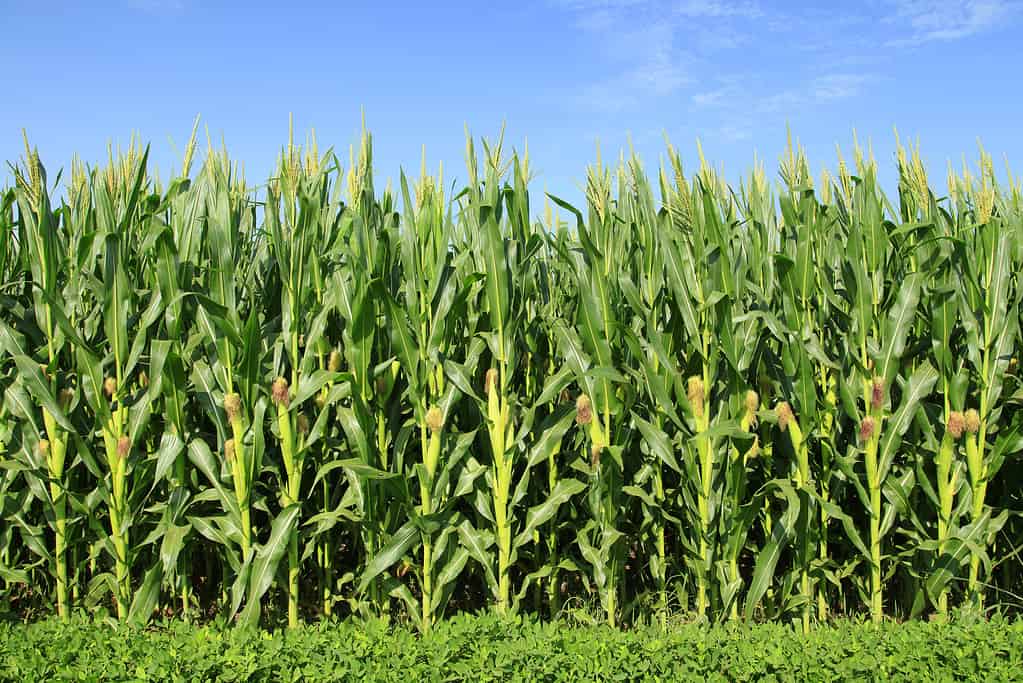
Although corn is a great companion plant, make sure to leave some space between the plants.
©iStock.com/zhengzaishuru
Corn is a universal staple crop that grows well as a neighboring companion plant with potatoes. Various soil-borne diseases, such as fusarium wilt and verticillium, affect potato yields, resulting in stunted growth, yellowing of leaves, and plant death. Corn acts as a beneficial potato companion plant, decreasing the risk of these common diseases. Furthermore, corn grows vertically in height, reducing ground competition and maximizing the underground soil space for potato yields.
As a plus, planting corn near potatoes can result in tastier potatoes!
Both corn and potatoes have similar growths, so plant both seeds at the same time, making sure to leave around 1 to 2 feet between each of the plants. You should also ensure not to sow the corn too densely, as you don’t want to shade the potatoes!
Horseradish
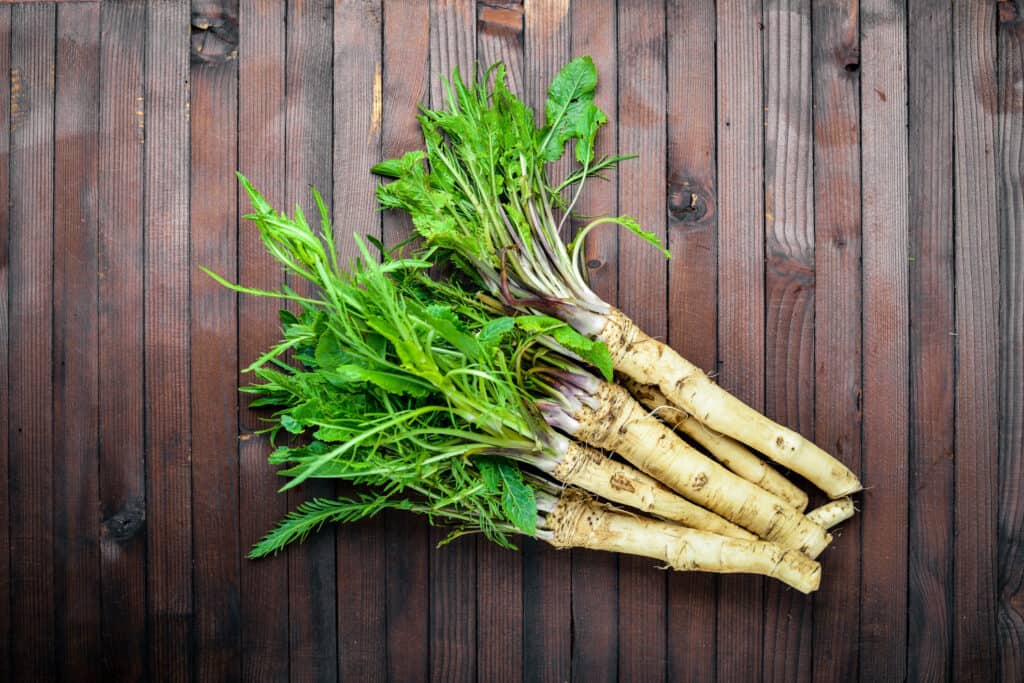
A root vegetable, horseradish is surprisingly a great companion plant for potatoes.
©iStock.com/Nataliia Mysak
Horseradish, a perennial root vegetable, has characteristic tapered roots that can improve soil aeration, benefiting nutrient circulation. The deep roots also help break up compact soil, allowing potato plants to absorb nutrients.
Besides this, horseradish is a natural pest repellent, improving disease resistance and boosting potato yields. The spice of the horseradish helps deter potato beetles, caterpillars, potato bugs, whiteflies, and aphids. The antibacterial and antifungal properties of horseradish further cement this amazing plant as the perfect companion plant for the potato as well as other plants.
The best way to plant horseradish alongside potatoes is to plant it surrounding your potato garden.
Marigolds
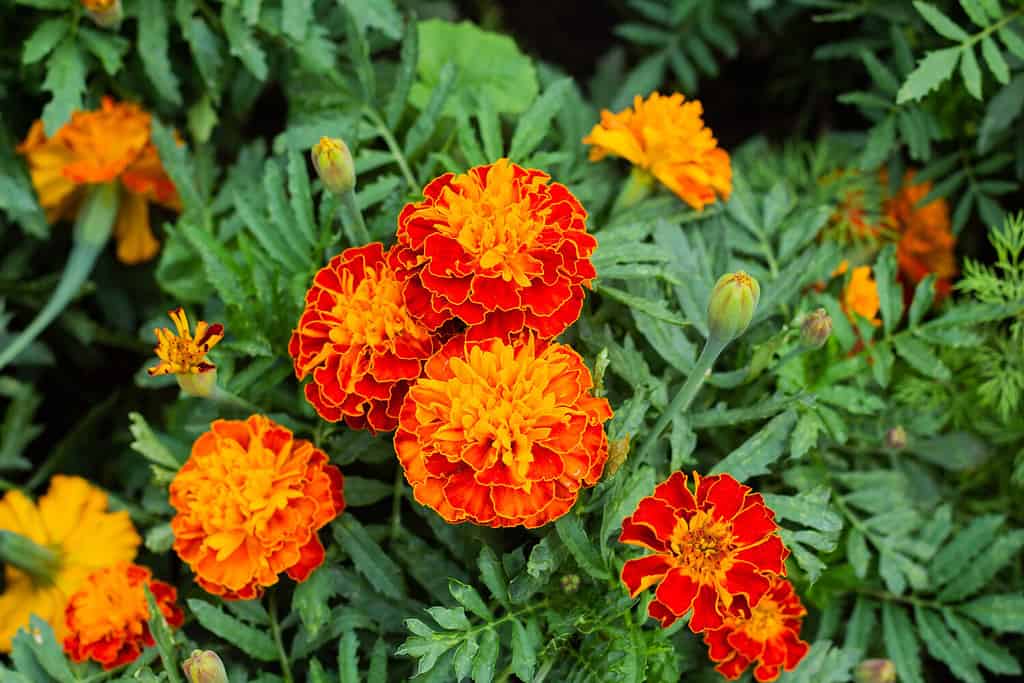
More than simply beautiful, marigolds can be beneficial to plant alongside potatoes.
©FunFamilyRu/Shutterstock.com
Marigold, a flowering plant producing vibrant blooms, is another beneficial companion for potatoes. It has a strong scent that acts as a natural pest repellent, keeping aphids and beetles away.
Marigold also releases certain compounds that suppress nematodes. Nematodes are tiny critters that attack the roots of potato tubers, reducing the yield. Therefore, marigolds can work as a natural nematode control mechanism for your potato crops as well! On top of all of this, marigold flowers also attract ladybugs, hoverflies, and lace wigs, natural predators of potato pests. Besides biological pest control, marigolds are also beautiful, so they can add a touch of beauty to your potato garden as well.
It’s best to plant marigolds and potatoes together in the spring to enhance the benefits of interdependence. You can also aim to plant marigolds between the rows of potatoes, as this intercropping will maximize pest control. But make sure the marigold does not overgrow and shade the potatoes.
Nasturtium
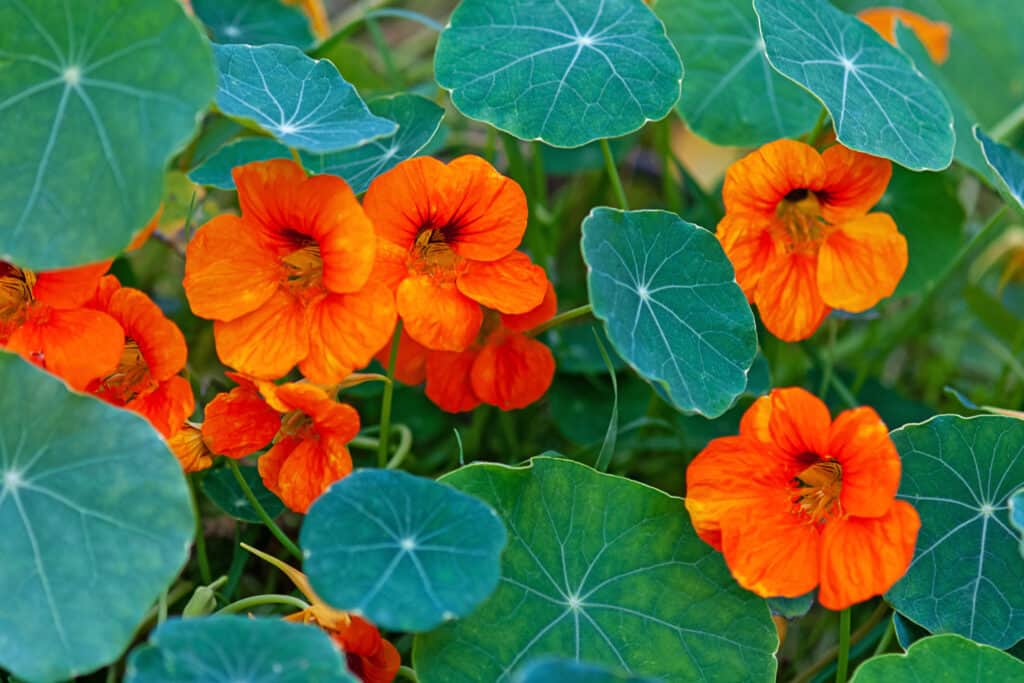
Plant nasturtiums a short distance away from the potatoes for best results.
©iStock.com/Nadya So
Nasturtium, a flowering plant with attractive flowers and green foliage, works as a prime potato companion plant due to its natural pest control properties. Thus, nasturtium is also a trap crop that can attract potato pests such as beetles and aphids away from your primary crop, minimizing pest infestations. The spicy scent of this plant may also work as a deterrent.
When you grow nasturtiums next to potato plants, you should ensure that you plant them at a short distance away from the primary crop to lure pests away. However, don’t plant them too close that they shade out your potatoes. You can plant both crops typically in early spring to maximize interdependence benefits.
Basil
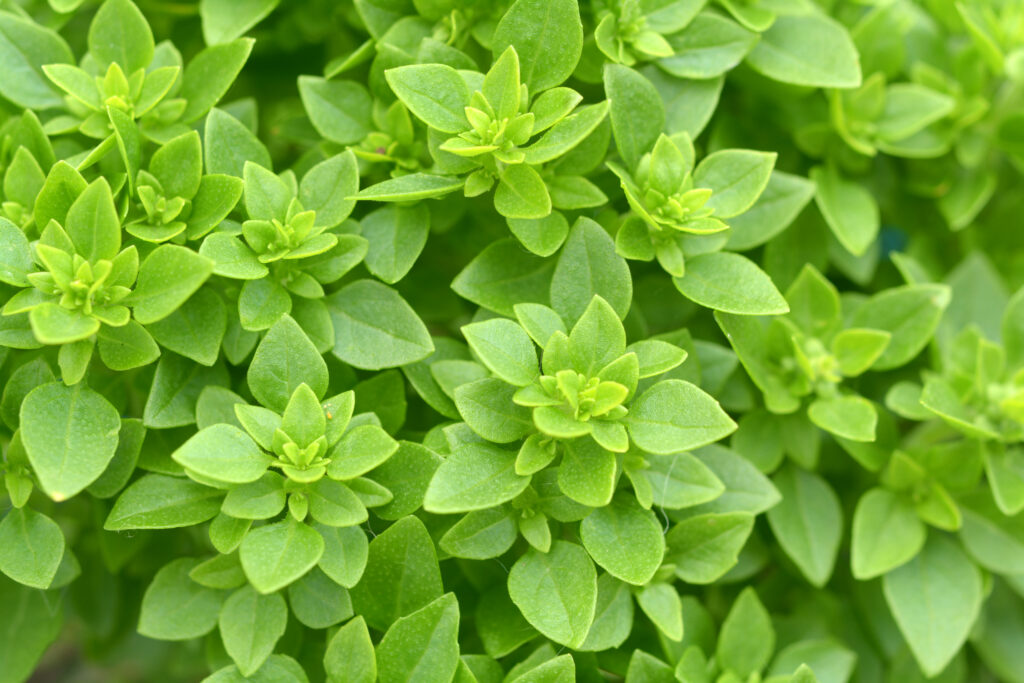
Another potato companion plant, basil helps improve the flavor of the tubers.
©AN NGUYEN/Shutterstock.com
Basil, an aromatic herb, is another great potato companion plant that improves potato flavor. Yum! It also emits a strong scent that acts as a pest repellent, deterring aphids, flies, and other harmful pests from finding your potatoes. Furthermore, the basil plant attracts pollinators.
For optimal benefits, you can directly plant basil near the potato crops in the early spring. Basil thrives in the same conditions as potatoes, needing some moisture, full sun, and well-drained soil. It also grows to around the same height as potatoes, so they won’t be competing for resources.
Cilantro
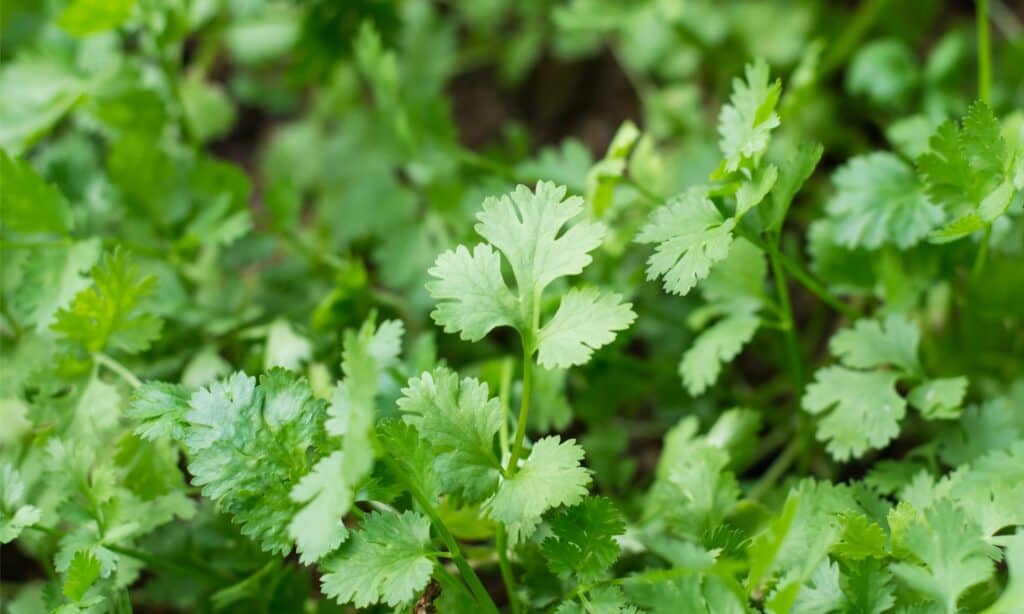
Cilantro’s aroma attracts beneficial predators and deters pests.
©iStock.com/Tevarak
Another great planting option is cilantro. With its strong aroma and alluring qualities for hoverflies, parasitoid wasps, ladybugs, bees, and lacewings, it acts as a natural pest repellent for potato crops. The hoverflies munch on mischievous potato pests like aphids and mites, making way for an excellent potato yield.
Like basil, you can plant it close to the potato to benefit from its aroma and promote this companionship. You can plant it at the same time as potatoes. Alternatively, you can plant them earlier on in the spring. Place the cilantro between the rows of potato tubers to act as ground cover.
Other herbs like parsley, thyme, sage, and rosemary are also good potato companion plants.
Spinach

Grow spinach with potatoes to reduce weed growth.
©iStock.com/JackF
Spinach is another great companion plant to grow with potatoes. Its long green leaves provide some ground cover for potato tubers, which can help reduce any excessive moisture loss. This also helps to reduce weed growth, which may compete for nutrients with your potatoes.
Moreover, spinach is a fast-growing crop with shallow roots, so it won’t hinder potato growth. Planting spinach and other leafy greens is an amazing way to take advantage of your space due to its shallow roots.
Plants to Avoid Planting Near Potato
Of course, there are also a number of plants to avoid planting near potatoes.
Eggplant
The fundamental problem of planting eggplants and potatoes comes from the fact that these two plants belong to the nightshade family, resulting in similar nutrient and soil demands.
These crops are also susceptible to the same diseases and infestations. Therefore, planting neighboring eggplants can result in nutrient competition, increased risk of pest infestation, and hinder the growth of potatoes.
Moreover, eggplants can make your potatoes more vulnerable to blight which causes wilting, rotting tubers, and dark lesions. The structural characteristics of eggplants also harm potato crops. Tall eggplants impede sunlight, resulting in stunted tuber growth and decreasing potato yields.
Fennel
Fennel is a garden crop that attracts swallowtail butterflies and other insects. These pollinating insects lay eggs on potato crops. Then, caterpillars feed on the neighboring plants when these eggs hatch, destroying potato tubers.
Fennel plants also produce chemicals that have a detrimental effect on the surrounding plants. These chemicals released from fennel significantly decrease the growth and yield of potato crops, so you should keep your potato crops away from fennel.
Fennel is also a host for plant pathogens, including fungi spores and bacteria which spread to potato plants, causing diseases that result in rotten tubers.
Cucumber
The cucumber is another plant you should avoid growing with your potato crops. They make terrible companion plants because they require a lot of water for growth. The nutrient competition can result in stunted potato growth.
In addition, the different growth habits of these plants can damage crop yield. Cucumbers require more space to spread and grow. Therefore, their foliage can occupy the surrounding space, leaving little room for the bushy potato plants to expand and grow. This overcrowding results in decreased tuber yield.
Root Vegetable
Root vegetables such as parsnips, carrots, and turnips are deep-reaching vegetables that utilize maximum underground space. When you grow these root crops in close proximity, they inhibit the growth of potatoes as there is limited space for them to grow as well.
In addition, root crops require potassium, nitrogen, and phosphorus, essential nutrients for your potato plants. Growing these crops together intensifies nutrient competition, hindering potato growth.
Sunflower
Sunflowers have a well-spread-out root system which creates competition for resources. Besides this, sunflowers have a considerable size and a vertical height, which can cast a shadow over underlying potato plants, obstructing sunlight.
Sunflowers also release chemicals that can stunt potato growth, reducing crop yield and tiny, misshapen potatoes.
Summary of the Best Potato Companion Plants
| Plant | Benefit to Potato |
|---|---|
| Chives | Natural insect deterrent for potato plants |
| Onions | Provide the best protection for growing potatoes |
| Beans and peas | Improve nutritional value of soil |
| Corn | Maximize space in garden |
| Horseradish | Repels potato beetles, aphids, and other common potato pests |
| Marigold | Natural nematode repellent for tuber protection |
| Nasturtium | Deters potato pests |
| Basil | Protects the potato plant with its strong smell |
| Cilantro | Acts as a natural pest repellent |
| Spinach | Has shallow roots that don’t compete with potatoes for nutrients |
The photo featured at the top of this post is © Tayvay/Shutterstock.com
Thank you for reading! Have some feedback for us? Contact the AZ Animals editorial team.







